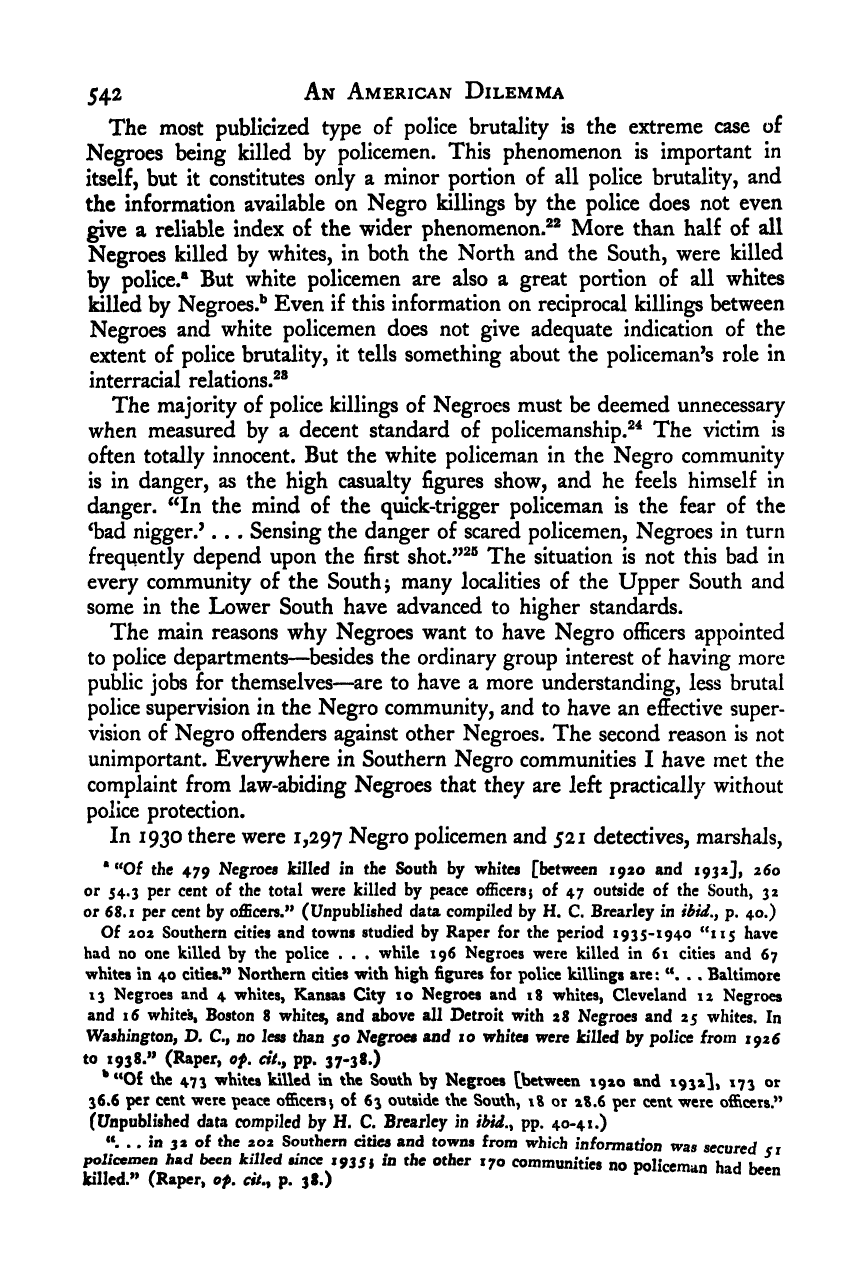Note: Gunnar Myrdal died in 1987, less than 70 years ago. Therefore, this work is protected by copyright, restricting your legal rights to reproduce it. However, you are welcome to view it on screen, as you do now. Read more about copyright.
Full resolution (TIFF) - On this page / på denna sida - VI. Justice - 25. The Police and Other Public Contacts - 3. The Policeman in the Negro Neighborhood

<< prev. page << föreg. sida << >> nästa sida >> next page >>
Below is the raw OCR text
from the above scanned image.
Do you see an error? Proofread the page now!
Här nedan syns maskintolkade texten från faksimilbilden ovan.
Ser du något fel? Korrekturläs sidan nu!
This page has never been proofread. / Denna sida har aldrig korrekturlästs.
542 An American Dilemma
The most publicized type of police brutality is the extreme case of
Negroes being killed by policemen. This phenomenon is important in
itself, but it constitutes only a minor portion of all police brutality, and
the information available on Negro killings by the police does not even
give a reliable index of the wider phenomenon.^^ More than half of all
Negroes killed by whites, in both the North and the South, were killed
by police.* But white policemen are also a great portion of all whites
killed by Negroes.** Even if this information on reciprocal killings between
Negroes and white policemen does not give adequate indication of the
extent of police brutality, it tells something about the policeman^s role in
interracial relations.^®
The majority of police killings of Negroes must be deemed unnecessary
when measured by a decent standard of policemanship.^^ The victim is
often totally innocent. But the white policeman in the Negro community
is in danger, as the high casualty figures show, and he feels himself in
danger. ^^In the mind of the quick-trigger policeman is the fear of the
^bad nigger.^ . . . Sensing the danger of scared policemen, Negroes in turn
frequently depend upon the first shot.”^® The situation is not this bad in
every community of the South j
many localities of the Upper South and
some in the Lower South have advanced to higher standards.
The main reasons why Negroes want to have Negro officers appointed
to police departments—besides the ordinary group interest of having more
public jobs for themselves—are to have a more understanding, less brutal
police supervision in the Negro community, and to have an effective super-
vision of Negro offenders against other Negroes. The second reason is not
unimportant. Everywhere in Southern Negro communities I have met the
complaint from law-abiding Negroes that they are left practically without
police protection.
In 1930 there were 1,297 Negro policemen and 521 detectives, marshals,
•“Of the 479 Negroes killed in the South by whites [between 1920 and 1932], 260
or 54.3 per cent of the total were killed by peace officers} of 47 outside of the South, 32
or 68.1 per cent by officers.” (Unpublished data compiled by H. C. Brearley in ibid,^ p. 40.)
Of 202 Southern cities and towns studied by Raper for the period 1935-1940 “115 have
had no one killed by the police . . . while 196 Negroes were killed in 61 cities and 67
whites in 40 cities.” Northern cities with high figures for police Idllings are : . . Baltimore
13 Negroes and 4 whites, Kansas City 10 Negroes and 18 whites, Cleveland 12 Negroes
and 16 white’s, Boston 8 whiter and above all Detroit with 28 Negroes and 25 whites. In
Washington, D. C., no less than 50 Negroes and 10 whites were killed by police from 1926
to 1938.” (Raper, of, ct/,, pp. 37-38.)
*“Of the 473 whites Idlled in the South by Negroes [between 1920 and 1932I, 173 or
36.6 per cent were peace officers} of 63 outside the South, 18 or 28.6 per cent were officers.”
(Unpublished data compiled by H. C. Brearley in iWd., pp. 40-41.)
«. .. in 32 of the 202 Southern cities and towns from which information was secured 51
poijcemcn had been killed since 19351 in the other 170 communities no policeman had been
killed.” (Raper, of. cit., p. 38.)
<< prev. page << föreg. sida << >> nästa sida >> next page >>